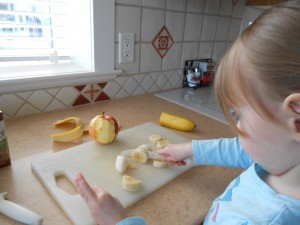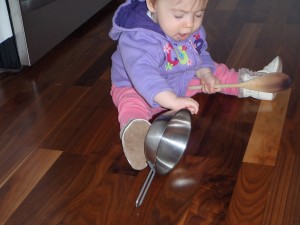 Saturday brunch is the best meal of the week because it is much less rushed and it can serve up some kindergarten readiness. For fun and learning, little hands can help in the kitchen. A favorite treat at our house is cut up fruit with some yogurt dip. Using a picnic knife, young kids can cut up a soft banana. Their hands can help stir the yogurt so it’s nice and creamy. Another way that a child can help is by putting the fruit pieces on plates.
Saturday brunch is the best meal of the week because it is much less rushed and it can serve up some kindergarten readiness. For fun and learning, little hands can help in the kitchen. A favorite treat at our house is cut up fruit with some yogurt dip. Using a picnic knife, young kids can cut up a soft banana. Their hands can help stir the yogurt so it’s nice and creamy. Another way that a child can help is by putting the fruit pieces on plates.
What are some other learning opportunities for children?
- Lots of language for sure: Just think of all the special words like rinse, bowl, stir, dip, plate, etc.
- Sizes: small, big, tiny, bigger than, smaller than, and just right. Seeing who got the bigger piece is comparing.
- Math: Kids are using math concepts when measuring and counting.
- Organizing: Both getting things and putting then away are organizing activities. We don’t think of having places where things go as a skill to be learned, but this is a basic system of organization. Just think of how many grownup activities depend on a system.
- Science: observing, predicting, or how change can be reversible or non-reversible; cut bananas can’t be put back together but yogurt can be spread out and piled up over and over.
- Social skills: cooperating, sharing, taking turns, and waiting.
- Prereading: using language for instructions, reading a recipe or picture clues.
- Muscle coordination: safe use of tools, stirring, spreading, dipping, and maybe even helping to wash up.
Letting kids ‘help’ in the kitchen builds their self-esteem and encourages their sense of belonging. These are extra ingredients in the recipe. Can you dish up some fun and learning for the little hands at your house?


![How do I develop my child's kindergarten readiness? shakers-300x225[1]](https://123kindergarten.com/wp-content/uploads/2012/08/shakers-300x2251.jpg)